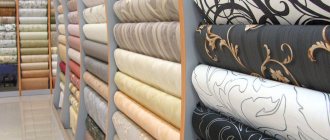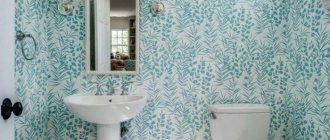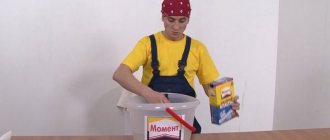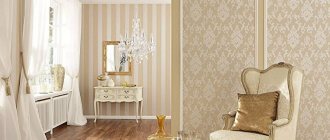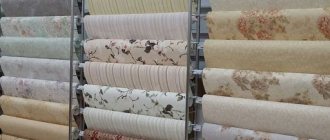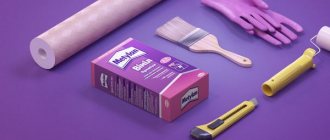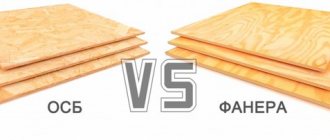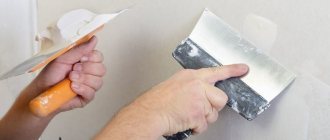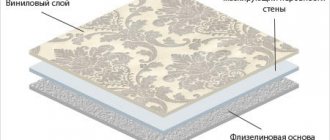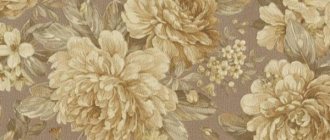0
31.08.2021
The market is replete with a variety of wallpapers. Anyone can purchase a suitable color depending on their individual preferences. However, having decided to make repairs, you must first decide what materials to purchase. Vinyl and non-woven wallpaper options are very popular. In order to understand which wallpaper is better, vinyl or non-woven, it is necessary to take a closer look at each type.
Wallpaper is of great importance in room design
How to distinguish non-woven wallpaper from vinyl
Page navigation
When choosing suitable materials for renovation, the question often arises of how vinyl wallpaper differs from non-woven wallpaper. In order to confidently distinguish between these two materials, you need to take a close look at the products.
Experts recommend paying attention to the following characteristics:
- Non-woven fabric is dyed, so this wallpaper has the appearance of fibrous cellulose. The material is dense and can be glued even to uneven and unprepared walls.
- Non-woven products are thin, unlike vinyl ones.
- Vinyl material is thick and highly resistant to mechanical damage.
- If you tear off a piece of non-woven wallpaper, small fibers will be visible, but the vinyl comes off smoothly.
- Vinyl sheets are dense and do not allow steam to pass through. It should also be noted that vinyl coating can be washed using detergents.
- If you look closely at the back of the vinyl product, you will notice embossing; non-woven fabrics have a flat back fabric.
The difference between vinyl and non-woven wallpaper is noticeable. Non-woven fabric is often used for rooms such as a bedroom or children's room. Vinyl material is suitable for the kitchen or hallway, as it is very easy to clean and does not absorb unpleasant odors.
The difference between vinyl and non-woven products is visible to the naked eye
Wear resistance
A very important factor is the strength of the wall covering. In this regard, non-woven fabric is in many ways inferior to vinyl. Natural cellulose has a loose structure, often the outer layer of non-woven fabric is corrugated and heterogeneous. Such wallpaper is very easy to damage with a sharp object or furniture. They can be damaged by cats or children.
Non-woven fabric wears out easily with close contact; it is best not to use it in hallways and kitchens.
Recommendation! Painting the wallpaper will help to slightly increase the strength characteristics of cellulose.
Dense vinyl, due to its “plastic” origin, is very wear-resistant. PVC coating is difficult to scratch, let alone tear. Even foamed types of vinyl coverings are more difficult to spoil than loose cellulose. Therefore, wallpaper based on polyvinyl is not afraid of the wheels of baby strollers, the claws of cats or the proximity of sharp corners. They can easily be used to cover balconies, loggias and corridors.
Non-woven fabric and vinyl - are there any differences?
The difference between non-woven wallpaper and vinyl is in the density and care features after gluing to the walls.
Vinyl is dense, easy to clean and can be glued to an unprepared wall. If you look closely you will notice that the material consists of several layers.
The non-woven fabric is also dense, but is not suitable for washing. Non-woven fabric can be painted immediately after wallpapering. The paper layer absorbs the paint evenly without leaving any traces.
Whoever purchases the material for the first time may make mistakes in assessing the characteristics. It is necessary to consult with a specialist so as not to make a mistake.
It is not enough to simply scroll through the catalog, since in reality the paintings may differ from the picture.
Pasting method
Since vinyl wallpaper is quite heavy, special glue is designed for it. Decorating the room should begin from the nearest window to the corner and distribute the canvas around the perimeter using a plumb line.
The peculiarity of gluing vinyl wallpaper is that while the upper part is carefully smoothed, the lower part must be kept rolled up in weight. This will prevent the material from sagging under the influence of glue.
Before applying the cut fragments to the wall, they are pre-treated with glue. However, this must be done within 10 minutes and no more, otherwise the paper layer will be damaged.
Go to the vinyl wallpaper catalog
Comparison of the characteristics of these types of wallpaper
To understand which wallpaper is better, non-woven or vinyl on a non-woven basis, you need to study the comparative characteristics in detail.
| Characteristic | Vinyl | Nonwoven |
| Lifetime | Durable use up to 10 years without loss of appearance. | 5-8 years depending on the location of gluing. |
| Resistance to mechanical damage | Used in rooms with animals and small children. | If scratches appear, it is necessary to re-glue. |
| Burnout | They don't burn out. | They burn out. |
| Method of gluing | They are heavy, so several people are needed when gluing. | The rolls are large and the material stretches well in the right direction. |
| Environmental friendliness | Contain substances harmful to human health. | Eco-friendly fabric, does not contain harmful elements. |
| Weight | They have heavy weight. | They consist of one layer so they are light in weight. |
| Price | They have an affordable price. | Expensive. |
When choosing the appropriate type for decorating the walls in a room, each person is guided by personal beliefs. However, vinyl and interlining have their own advantages and disadvantages that must be considered when purchasing.
If you want to hang wallpaper that will last a long time in areas with high traffic, for example, in the hallway or corridor, preference should be given to vinyl. For the living room and bedroom, preference is most often given to vapor-permeable non-woven wallpaper.
Non-woven fabric can be glued even to unplastered walls. The material hides unevenness and defects on the wall well, and is very popular.
Lifetime
It is impossible to unequivocally answer the question about the durability of the coating. According to the instructions for the wallpaper, vinyl lasts 10-12 years, the “life” of non-woven fabric is slightly shorter - 7-9 years. But these numbers don’t say much, since the service life of any coating is influenced by too many factors:
- indoor humidity;
- proximity to hot objects and heating appliances;
- purpose of the room (in the hallway the wallpaper takes on greater loads than in the living room);
- presence of children and animals in the house.
And this is not a complete list. However, this data is not so important, since it is rare that an owner will be able to “tolerate” the same wallpaper for more than seven years. The monotony simply becomes boring.
Another question is that all non-woven coverings can be painted several times with acrylic or water-based paint. By changing the color, the owner will receive updated walls. Vinyl coverings can also be painted, but not all - for this there must be a corresponding mark on the roll.
Difficulty of installation
This criterion is individual, however, as experts note, vinyl is more difficult to glue. Since the rolls are small and have a decent weight. In order for the product to stick to the wall, it is necessary to level it with a special spatula for several minutes.
Non-woven wallpaper is easier to install. Since the reverse side consists of cellulose, which quickly sticks to the wall. It should also be noted that the rolls are wide, which greatly facilitates the gluing process.
Non-woven fabric is easier to glue to the wall
Which ones last longer
This criterion largely depends on the intensity of operation. It is recommended to cover a room with vinyl if it is a walk-through room and there are frequent temperature changes. Therefore, vinyl is often used for the corridor, kitchen and hallway. The service life is much longer than non-woven fabric. Since vinyl is thicker and easily withstands mechanical loads.
The non-woven fabric is also of high quality and durable, however, in case of minor scratches, the damaged area should be re-glued, as it will be difficult to paint the wall. Therefore, it is not used in the kitchen and hallway. With careful use, non-woven fabrics serve for a long period, but it is recommended to periodically paint them to renew the color.
Vinyl is easy to clean, making it ideal for the kitchen
Which is easier to wash?
Non-woven fabric is environmentally friendly, therefore it does not harm human health and is often used for residential premises.
However, if wallpaper is chosen for ease of care, you should pay attention to vinyl. The canvas is of high quality and easy to care for after gluing. The walls can be washed, so this type is often chosen for the living room and hallway.
It should also be noted that vinyl is fashionable: you can purchase various colors and patterns and create an unusual interior design.
Vinyl is a moisture-resistant coating, so it can be used for rooms with high humidity levels.
What and for which room is better to choose
When choosing a suitable wall covering, it is recommended to first consider the type of room. Experts recommend observing the following features.
Hallway
This room regularly accumulates dirt that people bring in from the street. Therefore, the non-woven covering will serve for a short period and will quickly lose its appearance.
For such rooms, you should choose vinyl covering that will last for a long period without losing its appearance.
Kitchen
A room provided for cooking. Temperature changes and increased humidity levels are regularly observed in the kitchen.
That's why washable vinyl is often used in kitchens. It is also recommended to pay attention to the area of the kitchen table that gets dirty regularly. Vinyl is easy to clean, so using an apron over the table is not necessary.
Living room
Any canvas can be used for this room. However, non-woven ones are most often chosen, since they can be regularly painted in a new shade.
Children's room
Only breathable materials should be used in the child's space. Therefore, it is recommended to give preference to non-woven products.
Only natural materials are chosen for the children's room
Bedroom
For the bedroom it is recommended to use non-woven fabric. Such fabrics allow air to pass through well and do not accumulate dust.
When choosing a suitable wallpaper model, you should take into account the size of the room. You can find a wide variety of colors and textures on the market, so creating a unique design in the room will not be difficult.
It is also not recommended to use non-woven fabric in the kitchen because the material does not repel moisture. Therefore, after some time, spots may appear on the canvas that only need to be painted over.
Possibility of painting
Just two or three decades ago, it never occurred to any of us that wallpaper could be painted. Meanwhile, this simple solution allows you to achieve two goals at once. Firstly, no matter how diverse the range of wallpapers on the market is, there are always people who want something different, something that is not on the store counter, and painting helps to put their design idea into practice. Secondly, over time, even the most beautiful wallpaper gets boring, there is a desire to freshen up the interior a little, and here again a roller and a bucket of water-based paint come to the rescue, which provide an invaluable opportunity to change the color of the walls with minimal effort and money.
The most suitable base for painting is non-woven fabric. It is quite dense and has a pronounced relief, making it easier to retain a thick layer of water-based emulsion. Often such non-woven wallpaper is produced unpainted, since it is initially assumed that the next stage after pasting the walls will be painting work. Colored ones are less common, usually in warm pastel shades.
Painting vinyl wallpaper is also possible, but the requirement for a textured rough surface narrows the range of materials to wallpaper made of foamed polyvinyl chloride. There is one more limitation - the initial color must be light and monochromatic. Bright wallpaper cannot always be successfully repainted due to the high intensity of the original color.
Paper wallpaper with a relief texture is also suitable as a base for painting. They are thicker and denser than regular ones, so they practically do not deform when applying paint. Such wallpaper is impregnated with a special water-repellent composition, which allows the material to maintain its water resistance even after applying several layers of paint.
Experienced craftsmen claim that with each new layer of paint, the relief of the wallpaper becomes more pronounced. However, you shouldn’t get too carried away - repainting them more than 8-10 times (in some cases 12-15 times) is not recommended. In principle, this is more than enough - a rare person without pathologies changes the interior of his home more than once a year.
Among the wallpapers intended for painting there are non-woven, vinyl, and even paper, but the former are more common.
How to visually and tactfully distinguish one from the other
To see the difference between the canvases, it is recommended to take a closer look and take into account the following criteria:
- vinyl is thicker and consists of several layers;
- in vinyl sheets, embossing appears on the reverse side (the interlining on the reverse is smooth and pleasant to the touch);
- non-woven fabric is more textured and soft, and if you touch the vinyl you can feel the coolness.
If you have difficulty making a choice when purchasing, it is better to contact a specialist for help. You should also pay attention to the rolls. Each roll has a label indicating the type of material.
Paper wallpapers are very popular
The basis
Vinyl types of finishing can have a base made of either paper or the already mentioned non-woven material. This greatly affects the performance characteristics of the products and even how they will need to be glued. The structure of this material has several layers, each of which plays its own role. The only thing that is the same is the front side covering – vinyl.
Read also: What do your eyes say?
Paper bases are used to produce cheaper options. However, in appearance they are very similar to their more expensive counterparts. To find out what it is made of, you need to carefully look at the markings of the roll - the type of base is indicated there. If you have questions about the type, it is better to contact the manager, as this point may be decisive in your choice.
The paper is less durable and some difficulties may arise when gluing. Especially if you have no experience in such repairs. If not handled correctly, the canvas can change greatly in size during gluing and shrink after drying. This will cause gaps to appear at the joints of the strips.
Non-woven finishes do not have such serious disadvantages. And their price will be a little less. The same composition that was used for the base is applied to the front surface, only in a foamed state, and the structure will be single-layer. When the applied layer dries, it forms a very beautiful surface with a pronounced relief of the pattern. Some types of these coatings are purchased for further painting. Another significant factor will be the special properties characteristic of this type of finish.
What other wallpapers are there?
In addition to vinyl and non-woven, there are other types that are also very popular for indoor renovation work:
- Paper. Cheap products that are often used for gluing in bedrooms and living rooms.
- Textile. One of the most expensive types. The fabric is applied to a paper base. It has an attractive appearance and is often used for bedrooms and hallways.
- Photo wallpaper. Canvas with a large image. They can be paper type or non-woven.
- Acrylic. Thick canvas made of foamed acrylic. It allows air to pass through well and will last for a long period without losing its appearance.
- Glass wallpaper. A practical coating that can be used both at home and in the office. It has an attractive appearance and is suitable for painting.
Several types of canvases are often used to decorate a room. With the right shade and texture, the canvas can be combined with each other and create an unusual interior.
It is difficult to say unequivocally which wallpaper is better, non-woven or vinyl on a non-woven basis. When renovating, not only the type of canvas is taken into account, but also the size of the room and its type. For rooms that are regularly polluted, it is necessary to give preference to washable materials. Non-woven fabric is ideal for bedrooms and children's rooms.
Some useful tips
So:
- To understand how to distinguish vinyl wallpaper from non-woven wallpaper, just look at their edges; vinyl wallpaper will have a pronounced multi-layer structure, while non-woven wallpaper will have a homogeneous structure.
- If there are a lot of children and pets in the house, then it is better to give preference to vinyl wallpaper, as they are more durable.
- Before gluing vinyl wallpaper, the surface must be treated with several layers of impregnation to prevent the formation of fungus and mold; in the case of non-woven wallpaper, one layer of primer will be sufficient.
- As mentioned above, non-woven fabric absorbs odors well, but if you take wallpaper for painting, then this problem will not arise even when used in the kitchen.
